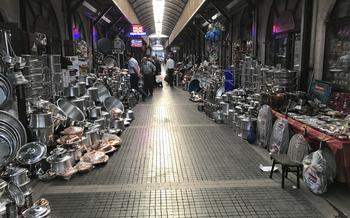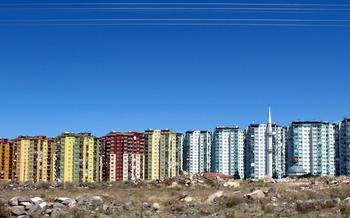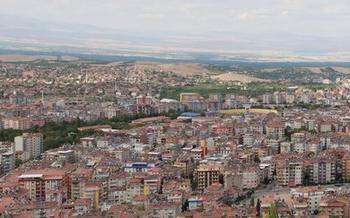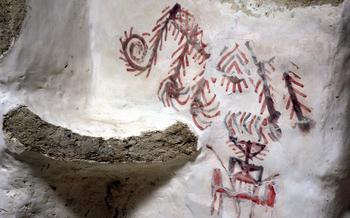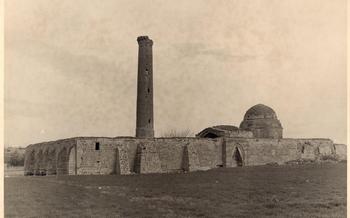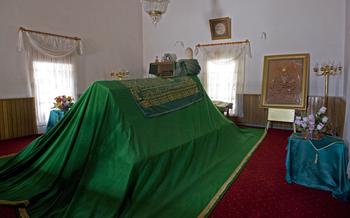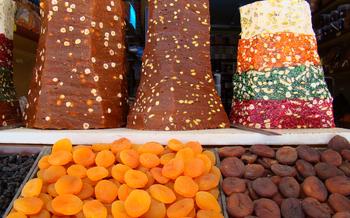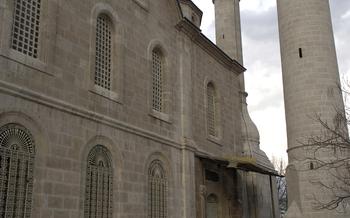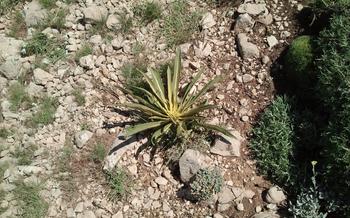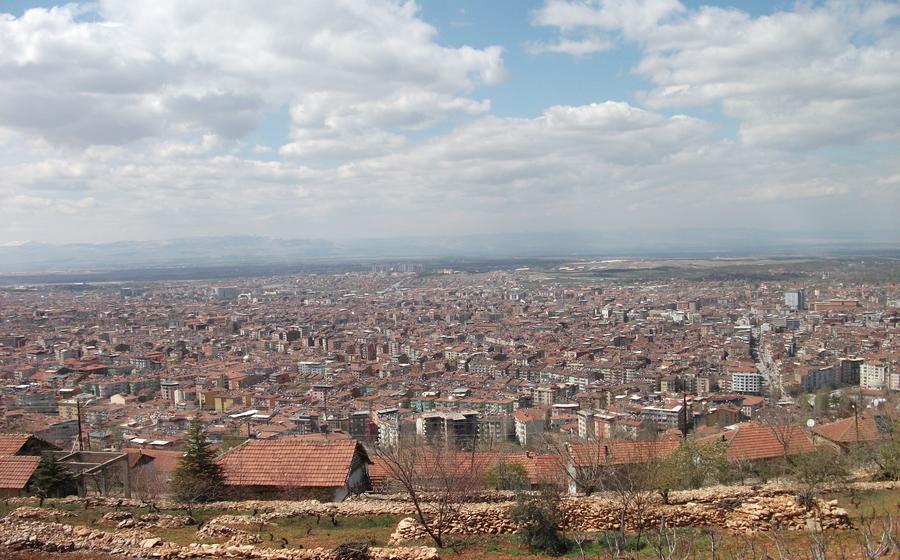
Hasan Gazi Tomb
- Hasan Gazi Tomb: A Majestic Symbol of Malatya's History
- Location and Accessibility: Finding the Hidden Gem
- Historical Context: Unveiling the Past
- Architectural Marvel: A Masterpiece of Seljuk Craftsmanship
- Cultural Significance: A Symbol of Unity and Heritage
- Visiting the Tomb: A Step-by-Step Guide
- Exploring the Surroundings: Hidden Gems Nearby
- Local Cuisine: Savoring Malatya's Delights
- Shopping for Souvenirs: Unique Treasures to Take Home
- Accommodation Options: Rest and Relaxation in Malatya
- Safety and Precautions: Ensuring a Smooth Journey
- Festivals and Events: Celebrating Malatya's Spirit
- Photography Tips: Capturing the Beauty of the Tomb
- Accessibility for Differently-Abled Visitors
- Insider Tip: Unveiling a Hidden Secret
Hasan Gazi Tomb: A Majestic Symbol of Malatya's History
In the heart of Malatya, nestled among the bustling streets, stands the Hasan Gazi Tomb, a majestic symbol of the city's rich history and cultural heritage. Built in the 13th century, the tomb is dedicated to the legendary Hasan Gazi, a revered figure in Malatya's past. Its octagonal shape and intricate tilework, a testament to the masterful craftsmanship of the Seljuk era, make it an architectural marvel that draws visitors from far and wide. The tomb holds a special place in the hearts of locals, serving as a reminder of their ancestors' bravery and resilience.
As I stood before the imposing structure, I couldn't help but feel a sense of awe. The tomb's intricate carvings and vibrant colors seemed to transport me back in time, to an era of epic battles and heroic deeds. I imagined Hasan Gazi, a valiant warrior, leading his troops into battle against formidable foes. His tomb, a symbol of his unwavering spirit and unwavering dedication to his people, stood as a testament to his legacy.
Location and Accessibility: Finding the Hidden Gem
The Hasan Gazi Tomb is conveniently located in the heart of Malatya, making it easily accessible to visitors. To reach the tomb, you can take public buses or taxis from the city center. The tomb is situated near several landmarks, including the Malatya Museum and the Grand Mosque. Once you arrive, you'll find ample parking spaces available near the tomb.
Insider tip: For a more peaceful and serene experience, visit the tomb early in the morning or late in the afternoon when the crowds are smaller.
Historical Context: Unveiling the Past
In the heart of Malatya's rich history lies Hasan Gazi, a legendary figure whose life and achievements are intertwined with the city's identity. As a valiant warrior and commander, Hasan Gazi played a pivotal role in defending the region from invaders and expanding the frontiers of the Seljuk Empire. His military prowess and strategic leadership earned him the title of "Gazi," a title bestowed upon those who fought in the name of Islam.
The Hasan Gazi Tomb stands as a testament to his legacy and the profound impact he had on Malatya's history. Built during the Seljuk era, the tomb reflects the empire's architectural influence and artistic prowess. Its intricate carvings, elegant tilework, and octagonal shape symbolize the fusion of Islamic and Anatolian architectural traditions.
Beyond its architectural significance, the tomb holds immense historical value as a symbol of Malatya's cultural heritage and the enduring legacy of Hasan Gazi. Locals venerate the tomb as a sacred site, paying homage to the legendary warrior and seeking blessings. The tomb's presence serves as a constant reminder of Malatya's rich past and the deep-rooted traditions that shape the city's identity.
Personal Anecdote:
During my visit to the Hasan Gazi Tomb, I was struck by the palpable sense of reverence that permeated the air. As I listened to the stories of Hasan Gazi's bravery and his unwavering commitment to his people, I couldn't help but feel a profound connection to the past. The tomb's intricate details and its serene atmosphere transported me back in time, allowing me to glimpse the grandeur of the Seljuk Empire and the indomitable spirit of Hasan Gazi.
Architectural Marvel: A Masterpiece of Seljuk Craftsmanship
The Hasan Gazi Tomb stands as a testament to the exquisite craftsmanship and architectural prowess of the Seljuk era. Its unique octagonal shape sets it apart from other structures in the region, creating a striking visual presence that captures the attention of visitors. The intricate stone carvings that adorn the tomb's exterior showcase the artisans' meticulous attention to detail, depicting beautiful floral motifs, geometric patterns, and Quranic inscriptions that add to its sacred significance. The decorative elements extend to the tomb's interior, where visitors can marvel at the vaulted ceilings, decorative niches, and a central chamber that exudes an atmosphere of serenity and reverence.
Personal Anecdote: During my visit to the tomb, I was particularly drawn to the intricate tilework that adorned its exterior. The vibrant colors and intricate patterns seemed to shimmer in the sunlight, creating a mesmerizing effect that held my gaze for a long time. It was a testament to the artistry and skill of the Seljuk craftsmen who had created such a stunning masterpiece.
Cultural Significance: A Symbol of Unity and Heritage
The Hasan Gazi Tomb holds immense cultural significance for the people of Malatya and beyond. It stands as a symbol of unity and cultural harmony in the region, representing the rich tapestry of traditions and beliefs that have shaped Malatya's identity.
The tomb is a sacred site for Muslims and plays a vital role in religious practices and beliefs. Pilgrims from near and far visit the tomb to pay their respects to Hasan Gazi and seek blessings. Special ceremonies and rituals are held throughout the year, attracting devout followers who come together to celebrate their shared faith and heritage.
Beyond its religious significance, the tomb is also a symbol of cultural unity. It represents the harmonious coexistence of different ethnicities and cultures that have called Malatya home throughout history. The tomb's architecture, with its blend of Islamic and Seljuk influences, reflects this cultural diversity and serves as a testament to the region's rich history of cultural exchange.
Moreover, the tomb has become an integral part of local traditions and folklore. Stories and legends surrounding Hasan Gazi and the tomb have been passed down through generations, weaving the tomb into the fabric of Malatya's cultural identity. These stories often highlight the virtues of bravery, generosity, and unity, inspiring locals and visitors alike.
Personal anecdote:
During my visit to the Hasan Gazi Tomb, I witnessed firsthand the deep reverence and respect that locals have for this sacred site. I observed pilgrims performing their rituals with great devotion, their faces radiating with a sense of peace and contentment. The atmosphere was one of unity and harmony, as people from all walks of life came together to celebrate their shared cultural heritage.
Visiting the Tomb: A Step-by-Step Guide
When planning your visit to the Hasan Gazi Tomb, it's essential to consider the following practical information:
-
Entrance Fees: There is no entrance fee required to visit the tomb, making it accessible to all visitors.
-
Visiting Hours: The tomb is open to the public daily from 9:00 AM to 5:00 PM, allowing ample time for exploration and contemplation.
-
Guided Tours: While guided tours are not mandatory, they are highly recommended for those who want to delve deeper into the history and significance of the tomb. Guided tours can be arranged through local tourism agencies or directly at the tomb for a nominal fee.
-
Dress Code: Visitors are expected to dress respectfully when visiting the tomb, as it is a sacred site for Muslims. Modest clothing that covers the shoulders and knees is recommended for both men and women.
Exploring the Surroundings: Hidden Gems Nearby
After immersing yourself in the history and beauty of the Hasan Gazi Tomb, take some time to explore the surrounding area and discover other hidden gems that Malatya has to offer. Just a short walk from the tomb, you'll find the historic Malatya Castle, which offers panoramic views of the city and the surrounding countryside. The castle is believed to date back to the Roman period and has been a witness to many historical events throughout the centuries.
Personal Anecdote:
During my visit to Malatya, I made sure to explore the area around the Hasan Gazi Tomb. I was particularly drawn to the Malatya Museum, which houses a rich collection of artifacts and exhibits showcasing the region's history and culture. I spent hours wandering through the museum, learning about the ancient civilizations that once thrived in this region.
If you're looking for a more natural experience, head to the Malatya Botanic Garden, located just a few kilometers from the city center. This beautiful garden is home to a wide variety of plants and flowers, as well as a small zoo with various animal species. It's the perfect place to relax and enjoy the outdoors, especially during the warm summer months.
For those interested in history and archaeology, a visit to the Arslantepe Mound is a must. This ancient settlement dates back to the 4th millennium BC and is considered one of the most important archaeological sites in Turkey. Excavations have revealed the remains of a large city, complete with temples, palaces, and fortifications.
No matter what your interests, you're sure to find something to your liking in the surroundings of the Hasan Gazi Tomb. Take some time to explore and discover the many hidden treasures that this historic city has to offer.
Local Cuisine: Savoring Malatya's Delights
Malatya's culinary scene is a delightful blend of traditional Turkish flavors and unique regional specialties. Visitors to the city should not miss the opportunity to sample some of the local delicacies that have made Malatya famous. One must-try dish is the "Malatya kayısısı," a sweet and juicy apricot variety unique to the region. These apricots are often used in desserts, jams, and compotes.
For a taste of traditional Turkish cuisine, try the "Malatya mantısı," a type of ravioli filled with minced meat and served with yogurt sauce and garlic. Another local specialty is "Malatya köftesi," meatballs made with a mixture of beef, lamb, and spices, grilled to perfection.
Vegetarians will find plenty of options in Malatya as well. The city is known for its fresh produce, including tomatoes, eggplants, and peppers, which are often used in vegetable stews and dishes. "Malatya patlıcan kebabı," a grilled eggplant dish with tomatoes, onions, and spices, is a popular choice.
To experience the local cuisine like a local, head to one of the many traditional restaurants or eateries near the Hasan Gazi Tomb. These establishments offer a warm and welcoming atmosphere, along with delicious food at affordable prices.
Personal Anecdote:
During my visit to Malatya, I had the chance to try the famous "Malatya kayısısı" apricots. I was amazed by their sweetness and flavor. I also tried the "Malatya mantısı," which was simply delicious. The yogurt sauce and garlic perfectly complemented the minced meat filling. I highly recommend both of these dishes to any visitor to Malatya.
Shopping for Souvenirs: Unique Treasures to Take Home
When visiting Malatya, don't miss the opportunity to take home unique souvenirs and handicrafts that reflect the city's rich culture and heritage. The local markets and bazaars are a treasure trove of authentic souvenirs, from handmade carpets and textiles to intricate metalwork and pottery.
Be sure to visit the Old Bazaar, located in the heart of the city, where you can find a wide variety of souvenirs and handicrafts at affordable prices. Here, you can bargain with the friendly vendors to get the best deals on unique items such as hand-woven kilims, traditional Turkish kahve sets, and exquisite jewelry.
For those interested in unique and authentic souvenirs, I highly recommend visiting the copper bazaar, where you can find a variety of beautifully crafted copper items, including traditional Turkish coffee pots, decorative plates, and intricate jewelry.
Remember to embrace the local culture and customs when shopping in Malatya. Be respectful and friendly, and don't be afraid to bargain with the vendors. Your efforts will be rewarded with unique and cherished souvenirs that will remind you of your time in this vibrant and welcoming city.
Accommodation Options: Rest and Relaxation in Malatya
When planning your trip to Malatya, finding comfortable and convenient accommodation is essential. Whether you prefer luxurious hotels or budget-friendly guesthouses, Malatya offers a range of options to suit every traveler's needs.
For those seeking a luxurious stay, the *Malatya Park Hotel is a top choice. Located near the city center, this five-star hotel offers elegant rooms and suites, a spa, a fitness center, and multiple dining options. The Divan Malatya Hotel* is another excellent option, providing modern accommodations, an indoor pool, and stunning views of the city.
For budget-conscious travelers, the *Malatya Hostel offers comfortable dormitory-style rooms and a communal kitchen. The Huzur Pansiyon* is another affordable option, providing simple yet clean rooms in the heart of the city.
When choosing a hotel in Malatya, consider factors such as location, amenities, and budget. Whether you prefer to stay near the Hasan Gazi Tomb or explore the city center, there are plenty of options to choose from.
Personal anecdote:
During my stay in Malatya, I had the pleasure of experiencing the warm hospitality of the *Malatya Park Hotel*. The staff was incredibly friendly and helpful, ensuring that my stay was comfortable and enjoyable. The hotel's location was convenient, allowing me to easily explore the city's attractions. I highly recommend this hotel to anyone visiting Malatya.
Safety and Precautions: Ensuring a Smooth Journey
Visiting Malatya and the Hasan Gazi Tomb is generally safe for travelers. However, as with any new place, it's essential to be aware of your surroundings and take necessary precautions to ensure a smooth and enjoyable journey. Here are a few safety tips to keep in mind:
-
General safety: Malatya is a relatively safe city, but it's always wise to be cautious, especially in crowded areas. Be aware of pickpockets and avoid walking alone at night in isolated areas.
-
Respectful behavior: Remember that Malatya is a conservative city, and it's important to be respectful of local customs and traditions. Dress modestly, especially when visiting religious sites, and avoid public displays of affection.
-
Dress code: When visiting the Hasan Gazi Tomb or other religious sites, dress respectfully. Avoid revealing clothing and opt for modest attire that covers your shoulders and knees.
-
Personal anecdote: During my visit to the tomb, I noticed that the locals were incredibly friendly and welcoming. However, I made sure to be mindful of my behavior and dress appropriately to show respect for their culture.
Festivals and Events: Celebrating Malatya's Spirit
Malatya is a city that knows how to celebrate its rich cultural heritage and traditions through various annual festivals and events. One of the most prominent is the Malatya Apricot Festival, held every July to honor the region's famous apricots. This vibrant festival features parades, music, traditional dances, and, of course, plenty of delicious apricot-based treats. Visitors can witness the Apricot Beauty Contest, where the best apricot growers and producers showcase their finest produce.
Another significant event is the Malatya International Film Festival, held annually in October. This prestigious festival showcases a diverse range of films from around the world, attracting filmmakers, movie enthusiasts, and celebrities. The festival includes screenings, workshops, and discussions, providing a platform for cultural exchange and appreciation.
During the holy month of Ramadan, Malatya comes alive with the spirit of Ramazan Festivities. The streets are adorned with colorful lights, and the air is filled with the aroma of traditional dishes being prepared for the evening feast. Visitors can experience the vibrant atmosphere of Ramadan bazaars, where they can find unique handicrafts, souvenirs, and local delicacies.
These festivals offer visitors a chance to immerse themselves in Malatya's vibrant culture and traditions. Whether you're a foodie, a film buff, or simply seeking a unique cultural experience, Malatya's festivals and events are sure to leave you with lasting memories.
Photography Tips: Capturing the Beauty of the Tomb
When visiting the Hasan Gazi Tomb, don't forget to bring your camera to capture the beauty of this architectural masterpiece. For the best results, consider the following tips:
-
Best angles: To capture the tomb's unique octagonal shape and intricate details, position yourself at an angle that allows you to showcase these features. Experiment with different angles to find the most flattering perspective.
-
Lighting conditions: The best time to photograph the tomb is during the golden hours, which occur just after sunrise and before sunset. During these times, the warm, diffused light enhances the colors and textures of the tomb's exterior.
-
Composition and framing: To create visually appealing photographs, pay attention to composition and framing. Use the tomb's architectural elements, such as the arched entrances and decorative tilework, to create interesting focal points.
Personal anecdote: During my visit to the Hasan Gazi Tomb, I found that the best angle to capture its grandeur was from a slightly elevated position. This allowed me to showcase the tomb's octagonal shape and the surrounding landscape. The warm afternoon light illuminated the intricate tilework, creating a stunning contrast against the blue sky.
Accessibility for Differently-Abled Visitors
The Hasan Gazi Tomb is committed to ensuring accessibility for visitors with disabilities. The site features ramps and elevators to facilitate wheelchair access, allowing visitors to explore the tomb's interior and exterior with ease. Additionally, trained staff is available to provide assistance and support to visitors with disabilities, including guided tours tailored to their specific needs. Accessible transportation options are also available, such as wheelchair-accessible taxis or private vehicles, to ensure a smooth and convenient journey to the tomb.
Personal anecdote:
During my visit to the Hasan Gazi Tomb, I witnessed firsthand the dedication to accessibility. I observed a group of visitors with disabilities being warmly welcomed and assisted by the staff. The staff members patiently explained the tomb's history and significance, providing them with a truly enriching experience. It was heartwarming to see the tomb's commitment to inclusivity, ensuring that everyone has the opportunity to appreciate its architectural beauty and cultural significance.
Insider Tip: Unveiling a Hidden Secret
Beyond the well-trodden paths, there lies a hidden gem waiting to be discovered by the discerning traveler. Nestled amidst the rolling hills that embrace the Hasan Gazi Tomb, a secret spot beckons with its breathtaking vistas and tranquility. For those seeking a unique perspective, venture off the beaten track and embark on a short hike to this secluded viewpoint. As you ascend, the landscape unfolds before you, revealing a panoramic tapestry of Malatya's natural beauty. The Hasan Gazi Tomb, with its majestic silhouette, stands as a sentinel against the backdrop of the distant mountains, its grandeur amplified by the play of light and shadow.
Alternatively, consider hiring a local guide who can unlock the hidden stories and legends that shroud the tomb. These knowledgeable individuals, steeped in the region's history and folklore, will regale you with tales of Hasan Gazi's exploits, the tomb's construction, and the cultural significance it holds for the people of Malatya. Their insights will transform your visit into an immersive and unforgettable experience.
If you seek a more intimate encounter with the Hasan Gazi Tomb, plan your visit during the off-season. The absence of crowds allows you to fully absorb the tomb's serene atmosphere, appreciate its intricate details, and connect with its spiritual essence. The tranquility of the surroundings will heighten your senses, enabling you to delve deeper into the history and symbolism that permeate this sacred site.
As you embark on your journey to the Hasan Gazi Tomb, embrace the spirit of discovery and be open to the unexpected. Whether you stumble upon a hidden viewpoint, engage with a local guide, or simply savor the tranquility of the off-season, you will undoubtedly leave Malatya with a treasure trove of memories and a newfound appreciation for its hidden wonders.
